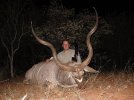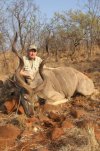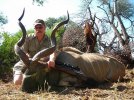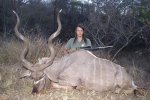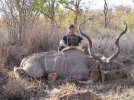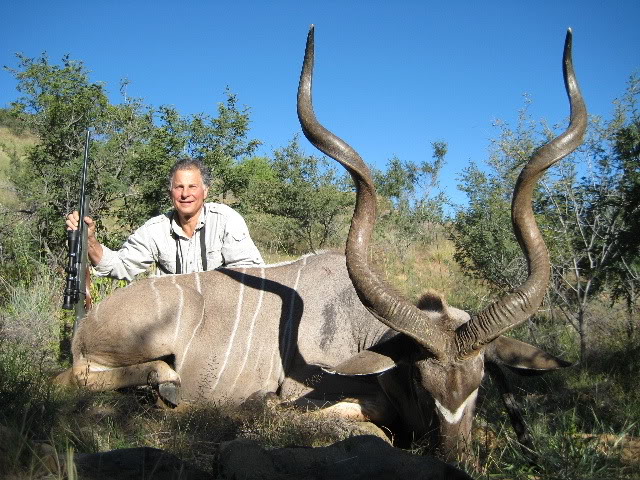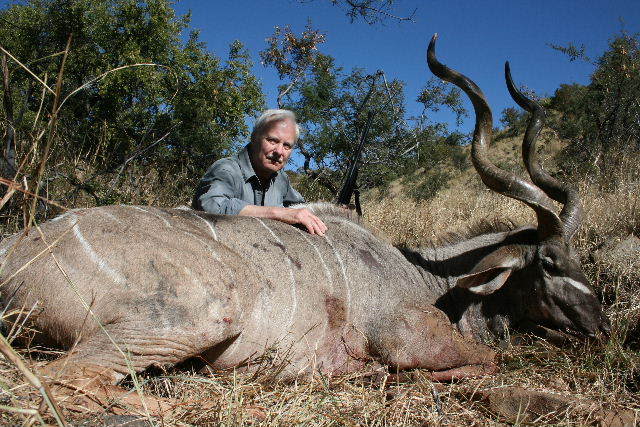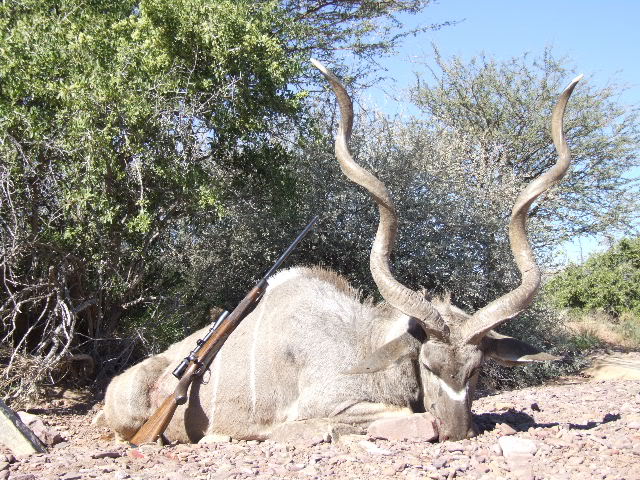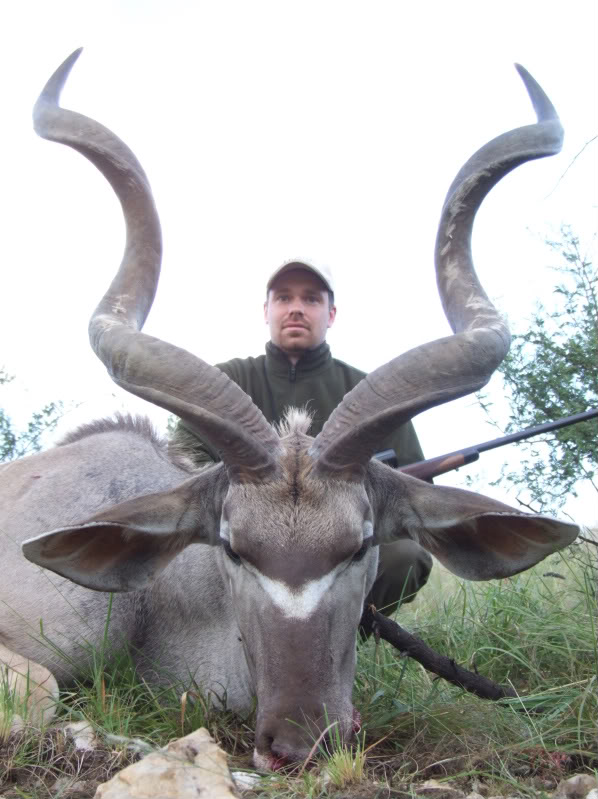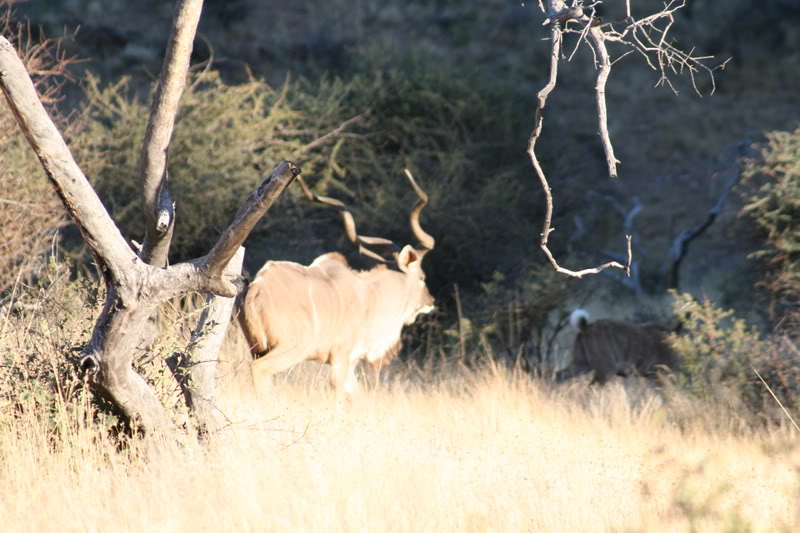The Greater Kudu is definitely one of Africa's most sought after trophies and has become the ultimate plains game trophy for many sport hunters.
When discussing Greater Kudu horn measurement here, I refer to horn length for a Kudu in it's simplest form which is taking the measurement of the longest horn from the base along the spiral ridge to the tip only. This, of course, is an easy method but for a primer on
How To Measure Your Trophies you can read AfricaHunting.com article by clicking
here.
I should start by saying that being able to consistently and accurately judge Kudu trophy size, quality and maturity is particular difficult and the most reliable way to get the trophy that you are looking for is to heed the advice of your Professional Hunter. Ultimately it requires having seen, taken and measured an awful lot of Kudus to become adept at judging this species.
Kudu usually have well matched symmetrical spiral horns, although the spread of the horns can vary greatly, from a narrow almost parallel look to a prominent wide "V" shape. Most often a prominent wide "V" shaped set of Kudu horns will look a lot more impressive. However the type of spread you prefer for your Kudu trophy is a matter of personal preference, many hunters really look for the wide "V" shape but you should know that the spread of the horns of a Kudu does not correlate to the length of the horns themselves.
01. This is a very prominent wide "V" shape spread on this Kudu
that appeals to many hunters.
02. This Kudu trophy has a narrow spread almost parallel look to
the horns and is still an exceptional trophy in every way... curl,
length, tips, mass; it's all there.
Using
Rowland Ward Methods Of Measurement for spiral-horned antelopes (Method 8) does require taking the spread measurement from horn to horn into account. However, using
Safari Club International Methods Of Measurement for spiral-horned animals (Method 2) does NOT require taking the spread measurement into account.
For a Kudu bull's horns to be fully grown, completing the second spiral is essential, however that does not necessarily mean that the Kudu bull is entirely mature when this occurs. It is important also to say that some Kudu horns will never come to a point and some points will never come out into their third curl either.
03.Here is an example of a fully matured excellent Kudu trophy
that the horns completed the second spiral however never
came to a point and would never have achieve that anyway.
left horn 53 1/2 inch (136 cm) - left base 10 3/4 inch (27.5 cm)
04. Here is an example of a immature Kudu bull that the horns
completed the second spiral however it's not finished growing
yet and still needs some time to grow and would have come to
a point.
I am a bit surprised at the amount of discussion about the white tips on the Kudu horn and it's importance in judging trophy size or maturity. I am of the opinion that white tips have no relevance in judging trophy quality or maturity what-so-ever, it is merely a genetic trait just as coat color or amount of neck fringe are, it is sometimes prominent and other times almost non-existent and none of these traits have any bearing on the quality of the trophy itself.
Thickness of the bases of the horns certainly can add a few inches to a SCI or Rowland Ward measurement as they take this into account, however there is no relationship between the thickness of the bases and the length of the horns. It is not uncommon to see a Kudu with incredibly long horns that are not particularly massive at the base, and this is no reason to pass up such a trophy. It may be aesthetically appealing to some hunters which is just a matter of personal preference.
05. Here is a super example of a spectacular Kudu trophy that
does not have thick horns but is a great trophy in every way.
right horn 54 1/2 inch (138 cm) - right base 10 1/2 inch (27 cm)
Usually if the tips of the horns are still very sharp and have a thin pointedness, the Kudu is either still growing or is just in its' prime. When Kudu bulls horns are past their prime they do not loose as much length as they age as some species do, such as Gemsbok / Oryx (see
Judging Gemsbok / Oryx article by clikcing
here), and their horns on the way down will often appear thicker at the top as their tips wear down.
06. Judging from the very sharp tips of this fine mature Kudu
bull, it could have gone a couple of years prior to being
harvested to have become a well aged bull.
left horn 50 1/2 inch (128.5 cm) - left base 11 inch (28 cm)
07. Looking at the thick tips of this great Kudu bull, you can see
that he is well aged and still has great length, he is just past his
prime and perfect for harvesting.
left horn 48 1/3 inch (123 cm) - left base 11 1/3 inch (29 cm)
Judging Kudu horn size simply based on the visual appearance of the length of the horns can be quite misleading. Kudu horn size can be very deceptive because of the optical illusion that is created by several factors combined. Here below are the aspects to look for.
08. Here is a good representation of visual trophy appearance,
while the top Kudu does not appear as impressive in length
using the back line as a guide, it's horn size however is probably
of similar length because of the depth of the curl as compared
to the Kudu below with tighter curls.
Probably the most important factor is the depth of the spiral which makes a tremendous difference in overall length of the horns. Kudu horns with less openess in the curl will keep the measurement down while Kudu horns with very deep curls (open spirals) will add tremendous length to the horns. In my opinion, this is where most really exceptional Kudu trophies are made...
09. Clearly in this split image, you can see the Kudu on the left has much less
open curls than the Kudu to the right with very pronounced deep curls adding
a lot of length.
Looking down the length of different Kudu horns from the tip through the center of the spiral, the size of the opening would vary tremendously depending upon the size of the curl. An extremely tightly curled horn could have an opening the size of a cherry, while a Kudu with very deep curl (open spirals) may have an opening the size of a grapefruit; that can add a lot of inches.
10. A good representation of a typical spiral curl.
If a Kudu bull's head is down to the ground and the horns reach or extend above the back line this can be a sign of an incredible trophy if coupled with a more prominent "V" shape.
11. Beautiful trophy with prominent "V" shape coupled with
exceptional length reaching the back line with generously open
spiral curls and above average tip length reaching to the third
spiral.
Length of the tips, this is where many incredible trophies are made, gaining several inches with well above average length of tips.
12. These two beautiful Kudu trophies are very similar in all
ways except that the top Kudu has slightly above average
length tips and the Kudu on the bottom clearly has exceptional
length tips and gains several inches on the other trophy just
because of that one factor.
In terms of trophy size when it comes to mature Greater Kudu bulls, the holy grail is taking the elusive monster 60 inch plus (152.4 cm) Greater Kudu which is something that does happen to a lucky few, however it is the result of the hunting gods smiling down upon you. I would say that horns above 55 inches (139.7 cm) make for an amazing trophy, horns above 50 inches (127 cm) make for a great trophy, horns above 45 inches (114.3 cm) make for a good trophy and horns below 45 inches (114.3 cm) make for a beautiful trophy and great memories!
13. Monster Kudu bull 64 inches, perfect in every way, has all of
the elements to make an exceptional trophy, great open spiral
curls combined with awesome length and extra long tips and a
wide open "V" spread.
I included numbers for each picture if anyone wanted to comment or refer to an image...














